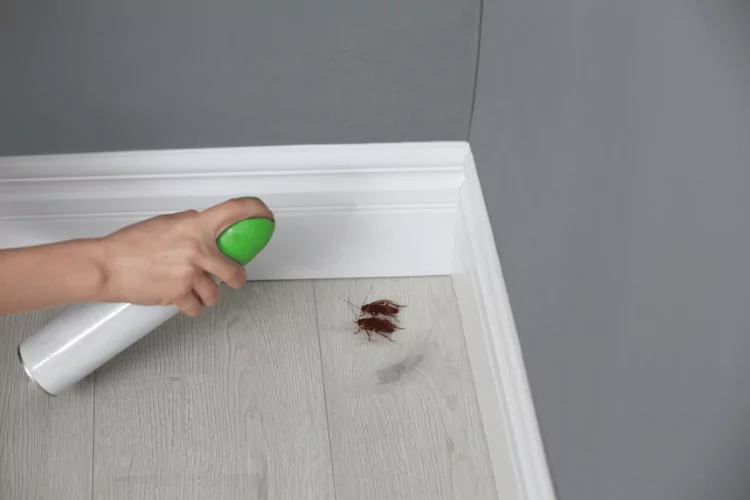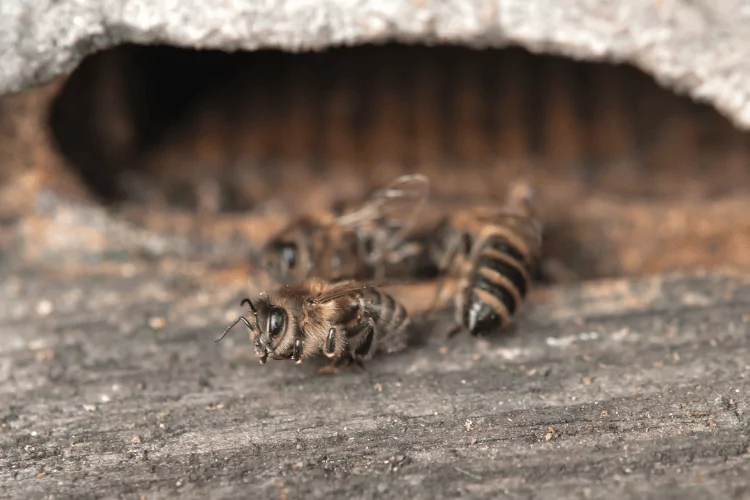Bug bombs, also referred to as insect foggers or insect control solutions, are pest control products many homeowners use to control bugs in their houses.
These insect foggers work by releasing insecticides into the air of an enclosed space to kill cockroaches, fleas, ticks, bed bugs, and other pests.
Now, with bee populations in decline, the last thing we want to do as both homeowners and beekeepers is inadvertently impact local bee colonies and hives. So, we’ve got to wonder, do bug bombs kill bees?
Let’s find out.
TL;DR
Chemicals toxic to insects, including the ones in bug bombs, also impact bees. They can disrupt nervous systems, mobility, and colony health. So, using bug bombs near beehives and pollinator habitats poses unintended threats and can definitely kill bees.
What Are Bug Bombs and How Do They Work?
Bug bombs contain insecticides in a pressurized can or aerosol spray canister. When activated, they automatically release fine mists of poison throughout the room, intended to either kill insects on contact or cause bugs to die shortly after exposure.
They are typically used for residual pest control in confined indoor environments only, like houses, garages, sheds, and small storage units.
Most foggers use synthetic pyrethroid insecticides as active ingredients, like pyrethrins and permethrin. Some use natural pyrethrins made from certain chrysanthemum flowers.
These chemicals are formulated to disrupt insect nervous systems when inhaled or upon direct contact with skin, leading to muscle paralysis and ultimately death.
Foggers allow a single pesticide application to spread through adjoining rooms over a period of 4 to 8 hours, providing control over roaches, yellow jackets, fleas, spiders, stinging insects, and other airborne pests throughout the home.
While bug bombs are a simple and popular pest control solution, their indiscriminate release of insecticides poses risks to bees and other beneficial pollinators.

Do Bug Bombs Kill Bees and Other Beneficial Insects?
The short answer is yes, bug bombs can certainly kill bees, either quickly after direct exposure or more slowly through contact with residual toxin deposits on flowers and other environmental surfaces.
This is because the synthetic pyrethroid and pyrethrin chemicals most foggers release are also highly toxic to bees. When bees encounter residues from foggers that have settled on flowering plants and garden vegetation, it can have dangerous effects.
These pesticides impact bee nervous systems very similarly to insects, leading to temporary paralysis, tremors, hyperexcitation, loss of coordination, and often death within 48 hours of exposure.
Even sublethal doses that don’t initially kill bees can have detrimental downstream impacts on bee cognition, social behavior, reproductive success, immune function, and overall colony health.
In fact, the Environmental Protection Agency prohibits or advises extreme caution regarding the use of pesticide products—including many foggers and permethrin treatments—anywhere near honey bees or beehives.
These regulations clearly indicate starkest bees are not compatible with typical bug bomb insecticides.
Research studies have shown that pyrethroid and pyrethrin exposure, even at relatively low concentrations, can significantly increase bee mortality rates.
Several investigations of large-scale bee poisoning incidents demonstrate that residues from total-release foggers near bee facilities have been responsible for hive losses in a number of cases.
While amounts may degrade over time, studies show pesticide deposits can linger for weeks or months on flowers, trees, and soil.
This gives bees ample opportunities for exposure and unintended impacts from indoor fogger use, especially those foraging in gardens, landscaping, window boxes, or other outdoor habitats in bloom.
While wasp bombs may provide temporary relief controlling nearby yellow jacket and wasp nests, drift from the pesticide fog may also inadvertently affect your more docile bee neighbors.
Tips for Safe Bug Bomb Use Around Bees
The threats posed depend partly on proximity. Using an insect fogger inside a well-sealed home likely presents less hazard to bees than deploying one in an attached garage with easy access to the outdoors.
Follow all label precautions—most advise avoiding use around bee colonies or anywhere bees are actively foraging. Carefully read fogger packaging warnings before use.
You can also take the following precautions to protect local bees and beneficial pollinators when using bug bombs for pest control:
- Avoid use near flowering plants, vegetable gardens, orchards, and other areas where you have observed active bee foraging. Be especially cautious around known hives or bee houses you may keep for honey production or crop pollination needs. Consider alternative pest control options in these zones, like targeted sprays, baits, and traps.
- Before fogging any attached garage or small outdoor shed, seal off exterior entrance points bees may use. Place tight netting or screen barriers over vents, holes in walls and any cracks bees could enter through. Close exterior doors and windows if possible. This limits the chances worker bees or foragers will become trapped and exposed during treatment.
- Carefully follow all re-entry interval warnings on the product container, waiting the recommended time frame before airing out spaces after fogger use. Never immediately open treated spaces—give pesticide residues time to settle out of the air for bee safety. Properly ventilate areas when re-entering per label instructions.
- Clean any beekeeping equipment or exposed surfaces in the treated area thoroughly with soap and water before reuse. This removes potentially toxic pesticide film residue.
What About Natural and Eco-Friendly Bug Bombs?
So-called “natural” foggers based on plant essential oils or other botanical insecticides like neem oil appear much safer if used judiciously. However, little formal study has evaluated their impacts.
While these naturally derived chemicals likely degrade faster than synthetic pyrethroids, they still require careful use around hives.
“Natural” does not automatically signify safety for bees. So, exercise caution and restraint where pollinators are concerned regardless of which type of fogger you select.

Alternative Pest Control Options to Minimize Bee Impacts
Insect foggers offer effective home pest control when used properly, but should be a last resort around bees. Start by trying lower-risk integrated pest management (IPM) strategies:
- Inspect carefully and seal cracks, holes, or points of entry so pests can’t access your home. Caulking and weatherstripping to exclude insects often solve issues without pesticides.
- Remove trash, clutter, and food debris promptly—eliminate sources of attraction. Improved sanitation and cleaning diminish pest pressure.
- Employ mechanical traps and monitors to identify locations of infestations precisely before treatment. Then target actions to affected areas only instead of whole-home fogging. This precision protects bees.
- Consider lower-risk gel baits, boric acid powders, or diatomaceous earth dusts. While also potentially harmful if brought back directly to hives by foragers, these materials pose reduced environmental impact compared to foggers.
- Use screened bee houses away from home access points rather than opening walls inside garages or attics. This separates colonies from pest problem zones.
- Call a pest control professional for severe infestations. They can assess bee risks on-site and discuss alternative management tactics suitable for your situation.
Wrap-Up
Pest control foggers offer an easy but toxic solution that carries unintended consequences for beneficial insects like honey bees and wild native pollinators essential to ecological balance.
While insecticides pose dangers, vigilant homeowners can take appropriate steps to control bugs without decimating backyard bees.
By carefully sealing treatment areas, following all label precautions, and exploring safer pest management alternatives first, we can sustain mutually flourishing pest-free homes and healthy vibrant bee colonies.
The lives of bees and the fate of the flowers, fruits, and food crops they pollinate depend on human accountability, restraint, and responsible action when managing home and garden pests.
- Does Bleach Kill Bees? - April 23, 2024
- How Do I Get Rid of Ants Without Harming Bees? - April 16, 2024
- Do Bug Zappers Kill Bees? Completely Explained - April 9, 2024
